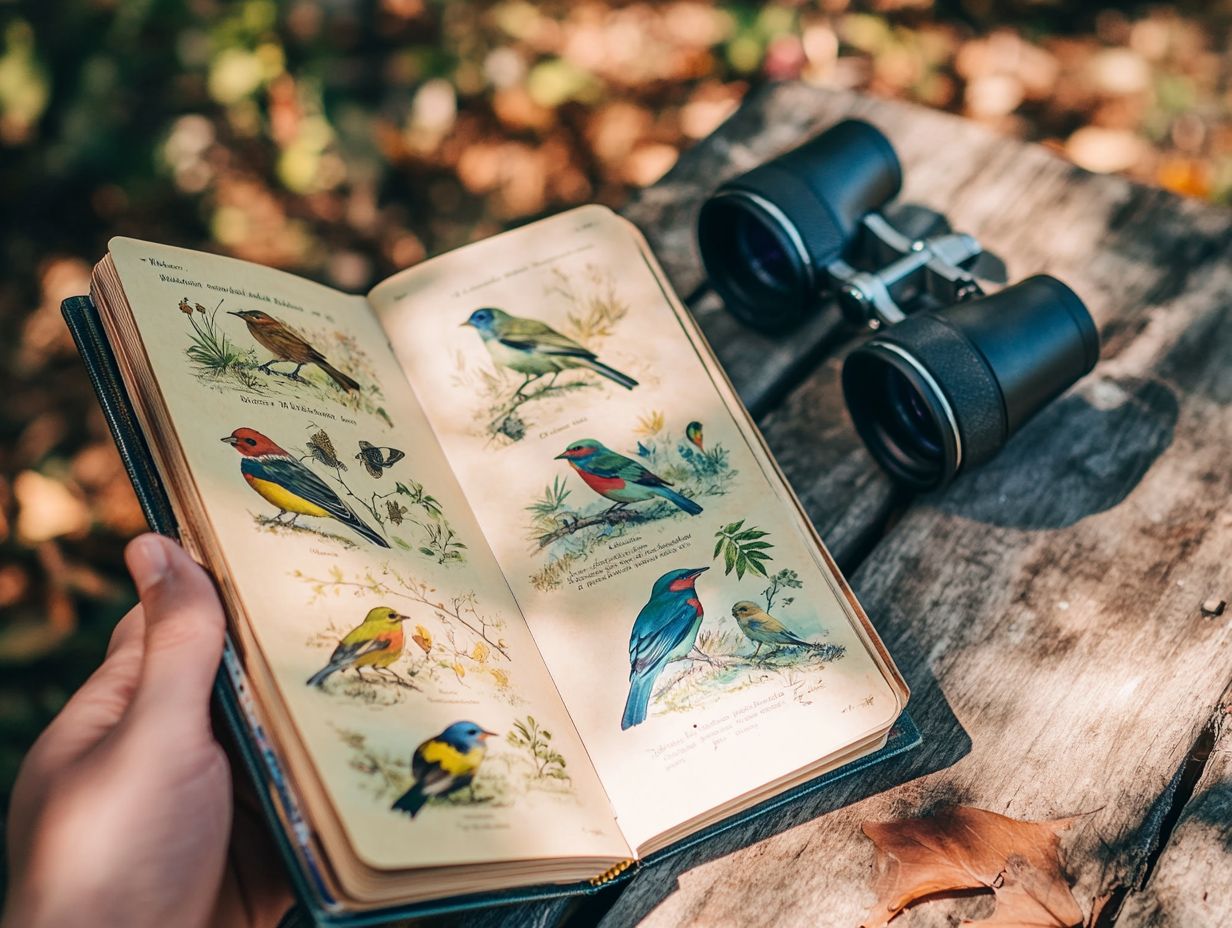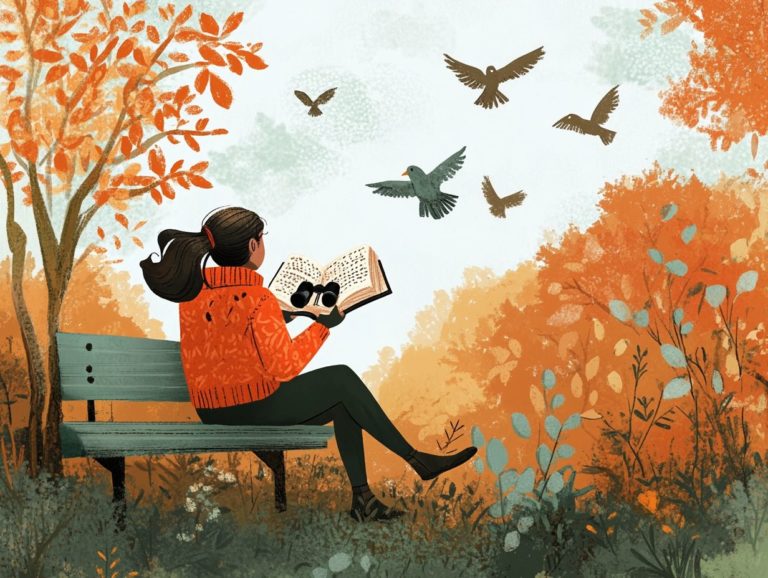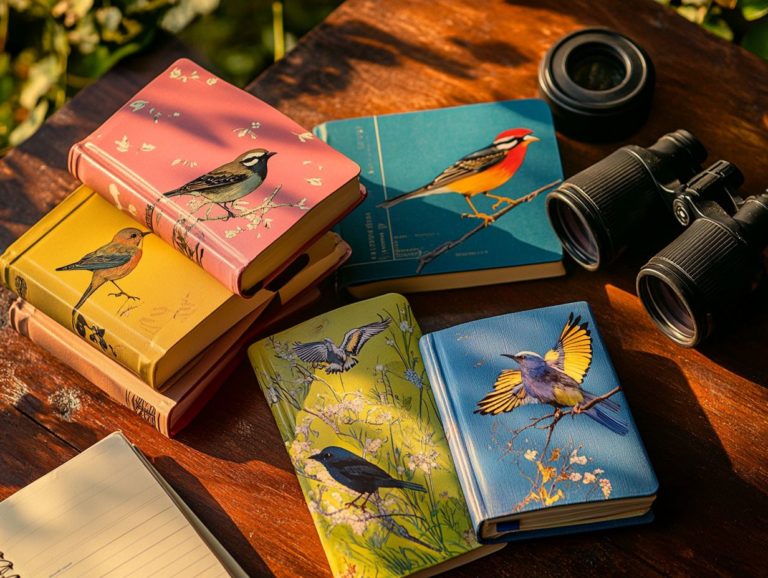Field Guides: A Beginner’s Companion to Birding
Birding transcends the realm of a leisurely pastime; it serves as a gateway to a deeper understanding and appreciation of nature.
Whether you are a curious novice or an experienced enthusiast, this guide equips you with everything you need to embark on your journey. From essential equipment and bird identification techniques in the field to respectful practices and advanced strategies, each section is designed to enrich your birdwatching experience.
Delve into common species, discover tips for attracting birds, and learn effective ways to share your observations with fellow enthusiasts.
Contents
- Key Takeaways:
- The Basics of Birding
- Identifying Birds in the Field
- Key Characteristics to Look For
- Using Field Guides and Apps
- Best Practices for Birding
- Respecting Wildlife and Their Habitats
- Etiquette in Group Birding
- Common Bird Species to Look For
- Advanced Techniques for Birding
- Frequently Asked Questions
Key Takeaways:

- Always respect wildlife and their habitats while birding to ensure their safety and conservation.
- Use field guides and apps to identify bird species accurately and efficiently.
- Consider advanced techniques such as attracting birds to your yard and recording and sharing your observations to enhance your birding experience.
The Basics of Birding
Birding is a captivating hobby that unites nature and wildlife enthusiasts as you observe and identify various bird species in their natural habitats. This wonderful pursuit offers a fun way to enjoy nature and discover its wonders!
As a beginner birder, understanding the basics of birdwatching can significantly enhance your experience, turning it into a rewarding journey through the diverse world of birds across North America. With the right field guides: navigating the world of birds in hand, you can explore various habitats and track different species, deepening your connection to the natural world.
What is Birding?
Birding, often known as birdwatching, is the wonderful art of observing birds in their natural habitats. This rewarding pursuit invites you to forge a deeper connection with nature.
The roots of this captivating hobby stretch back to the late 19th century, a time when individuals began to recognize the beauty and diversity of avian species, moving beyond the confines of hunting. Birding captivates enthusiasts of all ages and backgrounds whether you re a solo adventurer in search of tranquility or a family eager to embrace the great outdoors.
It not only provides a soothing escape from the daily grind but also cultivates a dynamic community where bird lovers exchange sightings, experiences, and insights.
As a beginner, you ll find immense value in the wisdom of seasoned birders. They are more than willing to share their expertise, helping you identify various species and understand their unique behaviors, ultimately enriching your enjoyment of this delightful pastime.
Essential Equipment for Birding
Having the right equipment is essential for elevating your birding experience, especially if you’re just starting out. Quality binoculars and reliable field guides will significantly enhance your observations.
When selecting binoculars, consider models like the Nikon Monarch M5 or the Celestron Outland; they can truly transform your ability to spot those elusive species. These options offer fantastic clarity and comfort, making them perfect for those long hours spent in the field.
A trusted field guide, such as the Sibley Guide, can be invaluable for recognizing different bird species. If you lean toward technology, popular birding apps are a treasure trove of information for identification and tracking.
By setting up feeder ports in your yard with a thoughtful mix of seeds designed to attract local varieties, you can turn your backyard into a birdwatching paradise, inviting a delightful array of colorful feathered friends.
Identifying Birds in the Field
Identifying birds in the field is a delightful blend of art and science. It demands your keen observation skills and a solid grasp of bird taxonomy, which is the classification of birds into categories based on their characteristics.
Practical resources, such as field guides and specialized birding apps, will elevate your experience, making the process not only enjoyable but also remarkably effective.
Key Characteristics to Look For

When you re out identifying birds, focus on key characteristics like coloration, size, behavior, and distinctive features. These traits help distinguish various species, especially from families like cardinals and fringillidae. Utilize your field guide for assistance.
To deepen your understanding, observe the shape and length of the wings. This reveals much about a bird’s flying capabilities and habitat preferences. The shape of the beak also offers insights into a bird’s diet, whether they prefer seeds, nectar, or insects.
Don t overlook unique songs and calls; these vocalizations are vital for identification, as each species communicates differently. A solid grasp of bird classification, or taxonomy, enhances your appreciation of the intricate connections within families like cardinals and fringillidae, enriching your overall birdwatching experience.
Using Field Guides and Apps
Field guides and birding apps are your go-to resources for immersing yourself in birdwatching. They offer a wealth of information on species identification, habitats, and behaviors. Cherished choices like the Sibley Guide and the Peterson Guide to Birds of North America are ready to elevate your experience.
These tools enhance your birding adventures and cater to your learning style. Printed field guides provide rich illustrations and detailed descriptions for easy reference in the field. Digital birding apps add flair with interactive features and the ability to play bird calls.
The Sibley Guide, renowned for its meticulous artwork, beautifully complements your observations. Meanwhile, Field Guides: Building Your Birdwatching Knowledge from All About Birds offers an extensive archive of audio recordings, making it easy to familiarize yourself with various species.
Together, these resources create a well-rounded approach to bird identification that is as informative as it is enjoyable.
Best Practices for Birding
Dive into the best practices of birding! Embracing these not only enhances your experience but also plays a crucial role in the ongoing conservation of wildlife and their habitats, vital for all bird enthusiasts.
By cultivating a respectful relationship with nature, you contribute to a harmonious coexistence between bird enthusiasts and the environment.
Respecting Wildlife and Their Habitats
Respecting wildlife and their habitats is crucial for you as a birdwatcher. It ensures that both the birds and their environments remain undisturbed and flourishing.
By adhering to certain principles, you can significantly contribute to avian well-being. Maintain a respectful distance from nesting areas, as getting too close can stress the birds and disrupt their natural behaviors. Steering clear of sensitive habitats helps preserve the delicate balance of ecosystems, allowing birds to thrive without human interference.
When you embark on your birdwatching adventures, equip yourself with binoculars to observe from afar. Avoid flash photography that could startle the wildlife. By sticking to designated paths and minimizing noise, you can enjoy your passion while ensuring that the natural environments you cherish remain intact.
Etiquette in Group Birding
When you engage in group birding activities, mastering etiquette is essential for enhancing your experience and camaraderie among fellow bird enthusiasts.
This approach allows you to appreciate the natural beauty while cultivating a sense of respect within the group. For instance, maintaining silence when others are observing creates an undisturbed experience, key for spotting elusive species.
Sharing equipment like binoculars or field guides shows your willingness to collaborate. Clear and respectful communication like signaling a spotted bird or gently reminding others to keep noise levels down enriches the shared experience.
This fosters an atmosphere where every member feels valued and included, making each outing memorable and creating fond memories among aspiring beginner birders.
Have you ever wondered how to identify a bird by its call? Join the adventure of birdwatching today!
Common Bird Species to Look For

Familiarizing yourself with common bird species across North America is a truly rewarding aspect of birdwatching. This knowledge not only enriches your experience but also enhances your ability to identify birds, making it enjoyable for enthusiasts at any level.
Identifying and Learning About Local Birds
Identifying local birds elevates your birdwatching experience and deepens your appreciation for the bird diversity right in your neighborhood.
Utilizing resources like detailed field guides provides you with valuable insights into the unique characteristics and behaviors of various species. Attending local birdwatching community events and workshops allows you to learn from seasoned enthusiasts while gaining practical experience in spotting these fascinating creatures in their natural habitats.
Online platforms are fantastic tools as well, giving you access to comprehensive databases and forums specifically dedicated to bird identification. By connecting with fellow birdwatchers, you can share your personal findings, exchange tips, and cultivate a rich sense of camaraderie rooted in a shared passion for nature’s winged wonders.
Advanced Techniques for Birding
As you progress in your birding journey, looking into advanced techniques significantly elevates your enjoyment and deepens your understanding of bird behavior. Tools like Nikon Monarch M5 and Celestron Trailseeker ED 8×42 binoculars improve your outdoor experience.
This exploration will help you attract more birds to your yard and enable you to record your observations with greater effectiveness.
Attracting Birds to Your Yard
Attracting birds to your yard is an exhilarating journey! Setting up the right bird feeders and choosing specific types, like platform feeders, entices a variety of bird species. The cardinal family and members of the fringillidae family are often frequent visitors.
By tuning into the preferences of your local avian visitors, you can whip up an enticing menu that includes seeds, suet, and nectar. For example, sunflower seeds are a beloved treat for finches and cardinals, while hummingbirds are irresistibly drawn to sugar-water solutions served in specially designed feeders. Incorporating native plants can also help attract a wider variety of species, enhancing your birding experience.
Place feeders in safe spots away from predators and ensure they are easily accessible. Keeping a clean feeding environment is paramount to prevent the spread of diseases among birds.
Incorporating native plants into your landscape enhances the habitat by providing natural food sources and shelter, encouraging greater diversity of birds to make your space their home. Use resources like the Peterson Guide to Birds of North America or National Geographic Field Guide to the Birds of North America to learn more about which plants best support local species.
Get started with your birdwatching journey today!
Recording and Sharing Your Observations
Recording and sharing observations is an essential aspect of the birding journey. It enables you to contribute to the community while enhancing your own learning through various birdwatching apps like Merlin Bird ID and eBird. Additionally, social platforms dedicated to birding foster this connection.
This interaction cultivates a sense of camaraderie among fellow bird watchers. It motivates you to document your encounters in diverse and creative ways. Many birders prefer to keep detailed journals, noting each sighting location, time, and behavior to create a personal archive of their adventures.
If photography is your passion, capturing stunning images can bring you immense joy. These visuals not only serve as records but also help you identify various species. The rise of digital tools, like the Sibley Field Guide to Birds of Eastern North America, has changed the game in how we track our birdwatching adventures!
Today, many enthusiasts utilize popular birding apps like eBird and Merlin Bird ID. These apps allow you to log sightings effortlessly, connect with others, and share findings. You also gain access to a treasure trove of resources to deepen your understanding of bird life. These tools complement traditional resources like the Sibley Guide to Birds.
Frequently Asked Questions

What is a field guide?
A field guide is a book or electronic resource used by birders to help identify different species of birds. It includes detailed information about physical characteristics, behavior, and habitat, along with illustrations or photographs for visual identification, making it essential for those interested in bridging knowledge gaps in birding.
Why is a field guide important for beginner birders?
Beginner birders find field guides essential. They provide the necessary information and tools to identify birds in the field. Resources like the Golden Guides Birds of North America and Audubon Bird Guide are particularly helpful for newcomers.
What should I look for in a good field guide?
A good field guide should have clear information, including illustrations or photographs of bird species. It should also be organized in a user-friendly way, featuring easy-to-use identification keys and range maps for each species. Resources like Field Guides: A Pathway to Birding Mastery are invaluable.
Are there different types of field guides?
Yes, there are different types of field guides available. These include regional guides, specialty guides (such as for waterfowl or raptors), and digital guides. Some guides focus on specific aspects of birding, like bird behavior or songs.
Can I use a field guide for other types of wildlife?
While field guides primarily help identify bird species, they can also be used for other wildlife, such as insects, mammals, and plants. However, field guides specifically designed for birds may not cover other types comprehensively. Resources like Birds of the World can be useful for broader wildlife identification.
How do I use a field guide in the field?
When using a field guide in the field, closely observe the bird. Take note of its physical characteristics, behavior, and habitat. Use the field guides to narrow down possible species based on your observations. You might find your Celestron Outland 8×42 binoculars for beginners helpful. Consulting with other birders or experts can also confirm your identification.






